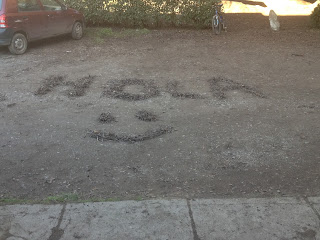Raking leaves around path between
dormitories and workshop
Work has also continued to include burning discarded materials such as trash and foliage. John and the campus gardener, Luis, have showed me how to start and control a fire. First material is placed together in a depression or in a pile above ground and then started with alcohol and the driest leaves and branches. After the fire has gained enough energy, more material is piled on top. Burning is a common practice in Chile, since there is not a large trash or leaf pick up service. Teachers instruct students in the agricultural education area on burning discarded materials, and the workers on the farm
burn the fields after harvest.
Pulling out branches to take to the burn pile
Luis managing the burn pile in El Vergel Park
Luis is the campus gardener and substitute
worker for any job needing an extra hand.
He is also a volunteer fire fighter
so has experience with fire management.
He is kind, hardworking and thoughtful. I
enjoyed working with him on projects in
the green areas at El Vergel.
A corn field on the commercial
farm being burned after harvest
Front of the museum (before)
Delineate planting area with wood shavings
Dig planting area and edge
for tile border
(John and Luis)
Add tile border
Place plastic under and around
plants to prevent weed growth
(Sebastian, a student)
Add plants and mulch
Front of museum (after)
Directing the students on how to plant a garden
through hands on learning
Students sifting dirt
Students planting
Students getting
creative with leaves
Junior year science class after
working in the new planting area
In addition, I joined the junior year science class students on a trip to Los Angeles, a larger city about 45 minutes from Angol, to see an exhibition at Santo Tomas University on human anatomy.
Junior year science class at exhibition
..….Smile!

















No comments:
Post a Comment